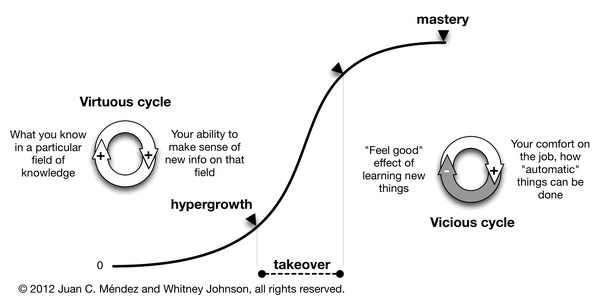I’ve had the experience before in life – as I am sure you have – of becoming absorbed in a new skill or topic, learning a tremendous amount, but then hitting a plateau at some point and never really advancing much further.
For example, I’ve had this happen with studying a foreign language. I could speak Russian quite well at one point, after a couple of years of very concentrated practice, but I never really advanced past the initial level I achieved. Indeed, not only have I not advanced, but my proficiency in Russian has now steadily declined over the course of a decade.
Maybe you have experienced something similar with learning a language, or a musical instrument, or with pursuing the advanced skills and thinking that could propel your career forward.
In any of these scenarios – and countless others – we may be sufficiently motivated to engage in deliberate practice, and by doing so, achieve a significant level of competence. But eventually, the gains in learning that we get from our practice start to flatten out. We practice, we study, we go through the motions, but we don’t really get better. In the case of my experience with Russian, my motivation began to wane and my pursuit of higher levels of competence – and ultimately, mastery – faded along with it.
This sort of experience – and the remedy – has been eloquently captured in a model developed by Whitney Johnson and Juan Carlos Méndez-García.
Johnson and Mendez-Garcia view learning and development as occurring along an “S-Curve” that starts slowly, accelerates for a period, and then flattens out. As Johnson puts it in a HBR Blog post:
As we look to develop competence within a new domain of expertise, moving up a personal learning curve, initially progress is slow. But through deliberate practice, we gain traction, entering into a virtuous cycle that propels us into a sweet spot of accelerating competence and confidence. Then, as we approach mastery, the vicious cycle commences: the more habitual what we are doing becomes, the less we enjoy the “feel good” effects of learning: these two cycles constitute the S-curve.
Here’s the S-Curve as it applies to learning:
While I have encountered similar “S-Curve” explanations of personal learning and growth before, I feel Johnson and Mendez-Garcia have done a particularly good job of capturing and illustrating the concept. More importantly, they suggest an approach to breaking through the barriers that may inhibit our learning. By being conscious of our learning cycles – and regular readers here know how much I emphasize consciousness in learning – we position ourselves to jump to a new curve as results on our current learning curve begin to plateau.
In the case of learning Russian, it is clear in retrospect that I had reached a point where I really needed to jump to a new learning curve if I was going to attain new levels of learning. This may have meant living in Russia for an extended period of time, or finding a job that required me to use Russian daily to earn my living. Whatever the case, I didn’t make the leap.
As it happens, that’s fine with me: I went down other roads and have never looked back (other than in this blog post, of course ;-). Even so, I think there is a great deal to be said for approaching life and learning a bit more strategically, for having a better sense of when it might be time to shake things up, take some risks, and make a leap. As Johnson puts it:
The S-curve mental model makes a compelling case for personal disruption. We may be quite adept at doing the math around our future when things are linear, but neither business nor life is linear, and ultimately what our brain needs, even requires, is the dopamine of the unpredictable.
Managing Your S-Curve
A McKinsey & Company article titled Shaping individual development along the S-curve, suggests how corporate learning and development organizations might play a role in helping individuals navigate their S-curves and thereby build overall business capacity. The article’s authors identify “four elements that determine whether professionals will successfully navigate from one S-curve to another.” Adapted slightly for personal use, these are:
Seeking opportunities
As committed lifelong learners, we need to make ourselves fully available for learning and regularly seek out new experiences, not only for the learning they offer, but also for the perspective they can give us on where we currently are in our personal growth and development. New experiences offer opportunities for reflection and can help us better see whether the need for a “jump” is approaching.
Appreciating progress
I’ve adapted this from “Rewarding performance” in the McKinsey article. In our personal pursuit of lifelong learning we can’t count on anyone giving us rewards for our progress. We can, however, learn to appreciate and acknowledge our own progress – and perhaps reward ourselves. Appreciating progress in this way is important for our own motivation as well as for recognizing when we’ve accomplished goals and, as a result, when it may be time to seek different, perhaps more challenging opportunities.
Mastering the skills of lifelong learning
This, of course, is a major focus of Mission to Learn. If we expect to move up our S-curves and jump to new S-curves, it is important to understand the ways of the successful self-directed learner and key practices that will make us more effective learners.
Developing confidence
Specifically, “developing the confidence to approach challenges in a constructive way.” Real learning inevitably involves a certain amount of risk. This is certainly true when jumping S-curves. Having confidence – which I think flows from believing in our ability to learn – is essential.
Ready to Jump?
If the S-curve looks like a useful tool, I recommend checking our Whitney Johnson’s new book, Smart Growth. While it is aimed at business readers, there is a ton in it that you can apply to your individual lifelong learning efforts. I also recommend checking out this Leading Learning podcast interview my colleague Celisa Steele did with Whitney.
Arguably to key to benefiting from the S-curve concept is to take the time to identify the curves you are on right now in your own life.
So, what curve are you navigating right now, and how soon do you think you may need to make a leap?
Jeff
P.S. – I am grateful to Whitney Johnson and Juan Mendez-Garcia for granting permission to use the images included in this post. I encourage you to read Whitney’s book and the HBR Blog Network post where I originally encountered them.








I’m not sure that’s proper name – probably just “logarithmic curve” is better fitting. That being said, it’s good rundown of a phenomenon that is prevalent in many places. Logarithmic growth is typical also for economic or biological mechanisms, so it definitely belongs to the context of learning too.
article is both reassuring and encouraging. describes my experience with German language learning to a “t”.
Walter – Thanks for commenting. I know what you mean re: languages – the path seems clearer, easier to see and track. In more abstract areas like writing – or leadership – it can be a lot harder to judge where you are and manage the curve. I encounter this all the time as I consider how to grow, improve in my business. I’ve found that just being aware of the concept – i.e., that we can reach a point where plateau and even start to decline or slide backwards – keeps me vigilant on the watch for new opportunities for innovation and growth. – Jeff
Great article, Jeff! 🙂 You’re so right… the plateaus we come across as we learn languages are so common and disheartening :/. For me there’s a time in my learning process when I think I make no progress at all in writing/speaking skills. Learning to understand a language (reading or listening to) seems to me like an easier nut to crack. With time I’ve found out that the ultimate key to master these output skills is working even more in the input (looking up unknown words, be immersed in the language as much as possible…). I don’t know how would that apply to other skills :D.